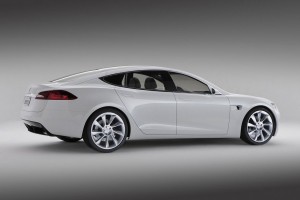As we cover the mobile industry, where the evolution of devices and processors is relentless, we’re used to being impressed. We’re used to seeing a new generation of a product that instantly and irrevocably makes the previous one look tame. It’s just the way this world turns. However, that’s not something we’re used to seeing in the automotive world, where each new model year is typically such a minor step forward that without the addition of new creases or wings to the body, bigger wheels and more boisterous badges on the trunk, you’d hardly spot the improvements.
 That’s not the case with the Tesla Model S. It comes not long after the retirement of the Tesla Roadster, a car we thoroughly enjoyed but found a bit too raw, a bit too rough around the edges for general consumption. The Model S is so much more refined, so much more polished that you can hardly compare the two. Yet they come from the same company and have one similar, defining characteristic: neither burns a drop of fuel. Join us after the break for an exploration of what makes Tesla’s latest EV such an amazing ride — and where the company must improve if it truly wants to compete with the BMWs and Mercedes-Benzes of the world.
That’s not the case with the Tesla Model S. It comes not long after the retirement of the Tesla Roadster, a car we thoroughly enjoyed but found a bit too raw, a bit too rough around the edges for general consumption. The Model S is so much more refined, so much more polished that you can hardly compare the two. Yet they come from the same company and have one similar, defining characteristic: neither burns a drop of fuel. Join us after the break for an exploration of what makes Tesla’s latest EV such an amazing ride — and where the company must improve if it truly wants to compete with the BMWs and Mercedes-Benzes of the world.
Where the Tesla Roadster was a repurposed Lotus chassis with a lot of customizations made to turn it into a battery-powered car, the Model S is a clean-sheet design, every aspect engineered with complete and utter disregard for internal combustion and all the tanks, pipes, hoses, pumps, radiators and other fittings that come along with it. As we learned when we spoke with (now former) Tesla Chief Engineer Peter Rawlinson, that provides a number of advantages.
Primary among them is the ability to put the weight of the car low. A car with a very low center of gravity will be a better corner-carver because weight up high makes a car rock from side to side as you turn from left to right. With the Model S, Tesla engineered a custom battery pack configured as a sheet that, when installed, runs the length of the car and is situated in the floor. It’s the heaviest and it’s also the lowest part of the car — well, other than the bottom of the wheels and tires.
This is a heavy car, 4,600 pounds or so, but this concentration of weight so low means that it handles like a lighter, more nimble auto. But that’s not the only benefit. This battery pack arrangement gives the car a flat floor to build upon, which means a wide-open interior, uncompromised by a transmission tunnel, and a relatively massive 31.6 cubic feet of cargo space spread across the front and rear trunks. (The BMW 5 Series offers less than half that, just 14 cubic feet.)
The electric motor itself is sandwiched between the rear wheels, again positioned low and out of the way, and depending on which specification you choose, you’ll get a different motor with different outputs.
The car we were given to test was a top-shelf Performance model, with the 85kWh battery pack and plenty of other options: upgraded audio system ($950), the “tech package” that includes GPS nav and a very trick proximity-based key ($3,750) and some other goodies that brought the sticker price just into the six-figure mark: $101,600 to be precise. Of course, there is a $7,500 tax credit that helps to ease the sting somewhat, and the EPA rating of 89MPGe is estimated to save the average consumer $9,100 in fuel costs over five years. Depending on your driving habits, you might